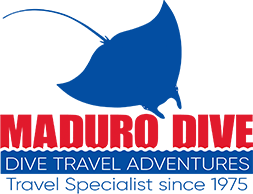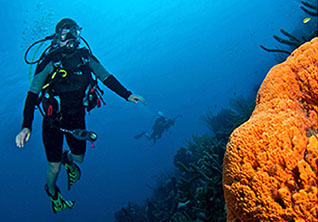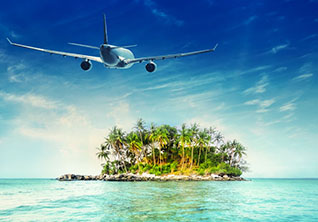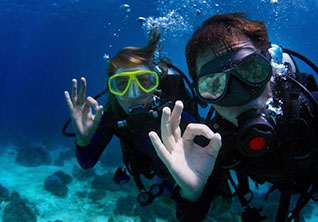Cage Diving with Great White Sharks: Africa and Australia
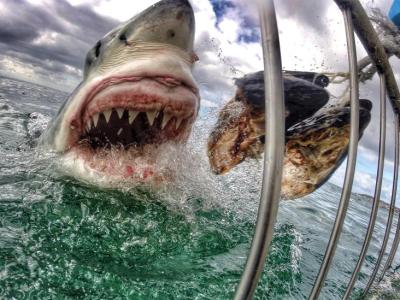
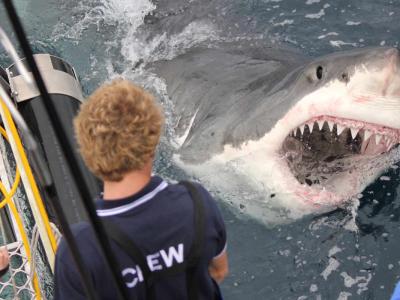
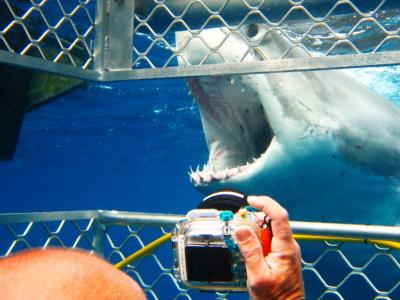
Being in a cage in saltwater next to free swimming great white sharks is probably the best way to get an adrenaline rush on this planet. It is also one of the safest ways to see these magnificent creatures close up and personal in the wild. Cage diving was first invented by Rodney Fox of Australia after he survived being mistaken for a possible meal. It could be equally argued that keeping certain tourists behind metal bars is a potentially good measure for keeping great white sharks safe too. Currently there are three locations around the world where local governments permit cage diving: Australia, South Africa, and Guadalupe Island off of Baja California, Mexico. In this article we will concentrate on single day trips out of South Africa and Australia, as Guadalupe Island because of its distance to the mainland entails exclusive liveaboard diving.
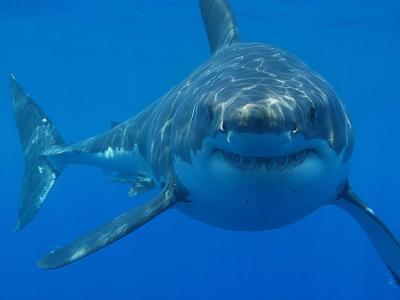
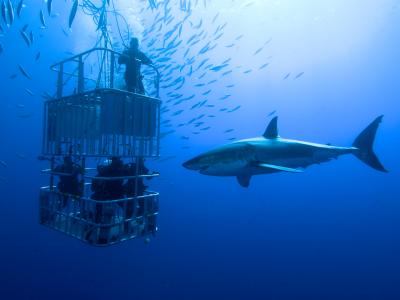
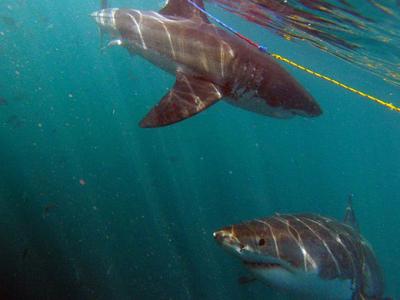
Starting in Cape Town South Africa, you have to drive 2.5 to 3 hours to the seaside village of Gansbaai and a short distance to Kleinbaai Harbour where up to 8 different government authorized charter boats go out to visit great white sharks. Some of the tours will pick you up in Cape Town early in the morning around 4:30 am to make the trip to Gansbaai, while others ask you to come or bring you to Gansbaai the night before the trip to stay in a guest house or lodge; so you don’t have to get up quite so early the day of your great white shark encounter. The reason these trips leave dockside so early is because great whites prefer to hunt at first light and this is the time when you are most likely to see them breach; jump out of the water . Some great whites may breach year round so you always want to have a camera ready around False Bay and Mossel Bay.
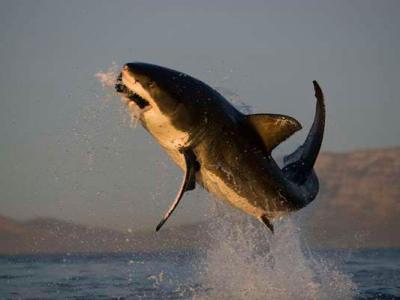
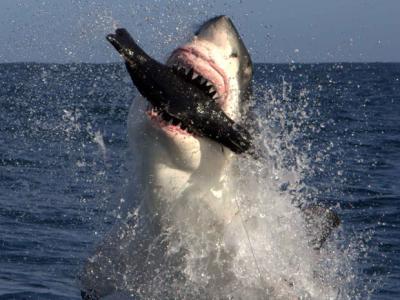
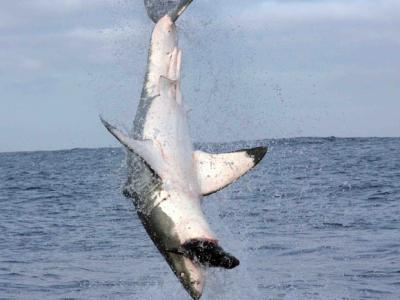
From April to September charter operators may witness over 600 breaches where a great white, whose attack pattern is from depth below to the surface, may shoot out of the water at speeds of up to 25mph (40km/hr.) and soar some 10 feet (3m) up into the air before arching back down towards the water. If the Great white was lucky, and fifty percent of the time they are not, they will have managed to stun or bite a seal just as they cleared the surface. During this first bite, the great white will determine many factors such as how wounded or stunned was the prey, it’s fat content, taste, smell, and if it is worth pursuing further by immediately biting again, or cautiously following at a safe distance while gathering more sensory data before committing to further feeding or determining the bite test is over and any further pursuit is a waste of energy. This fundamental mental process is what has saved many of the humans that have survived the actual overall and surprisingly low number of recorded great white shark bite test encounters as human fat content is disappointedly poor compared to fat enriched cape fur seals; provided one can survive the initial bite and potential great loss of blood. Besides seals, great whites also prefer Jackass Penguins, Dolphins, and seabirds. The millions of humans swimming in the ocean each year are really not on their calorie count list, but the outlines of humans on surfboards, which resemble from below shadows of seals, can from time to time be too tempting to resist an inquisitive bite test.
So going back to first light, you may have a light breakfast and briefing before they take you out on a fifteen minute ride to Shark Alley which is a channel that separates Dyer Island from Geyser Rock. Geyser Rock is the main breeding ground for 40-60,000 cape fur seals. For those times of the year when breaches are few and far between, boat operators go right into chumming the water to attract great whites. This is soon followed by divers rotating in and out of cages to view from below the water line or divers seeking higher ground to film the inquisitive great white sharks from up above. Some of the boat operators require you to have a basic diver certification while others do not. Some cages are bigger than others, but most cages are attached to the boat and are made to float; not sink. They may chum the water and set bait out for great whites to follow, but they try not to directly feed the sharks as they don’t want to alter the shark’s natural behavior any more than necessary. They are greatly aware how important these apex predators are to the ecosystem and some trips have onboard dedicated marine biologists to help answer any questions that you may have. Financially, a set of jaws may fetch $20,000, but one week of great white tourist trips can bring in up to $30,000 in revenue, and that amount is possible every week the boats go out. Now on the emotional side, some locals have watched a great white named “Slashfin” grow from just over 3 feet (1m) shark with a severely cut up fin to a 15 foot (4.5m) long shark with a healed fin with a mere two scares in just under 6 years. It’s amazing how you can get so attached to some of these majestic creatures in the space of a few hours. We should mention that from July to November you might also see Southern Right Whales while out on the water.
Things you need to bring include: swimsuit, a water resistant out of water cover, dry change of clothes, camera, sunscreen, sunglasses, chap stick, seasick medication (if needed), and a hat. Perhaps even a towel if not rented or supplied. The best operations supply you with cold water gear including thicker wetsuit, booties, hood, and perhaps even a weight belt and mask. They may also provide you with snacks, soup, and beverages, or will ask you to bring extra cash for particular snacks, refreshments and for a DVD copy of your “Day with Great Whites”. You might also desire to combine diving in other areas or include safari reserve trips or wine tasting trips as part of your South African holiday adventure.
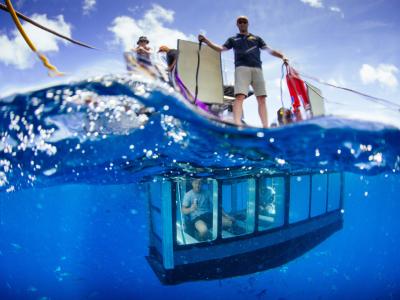
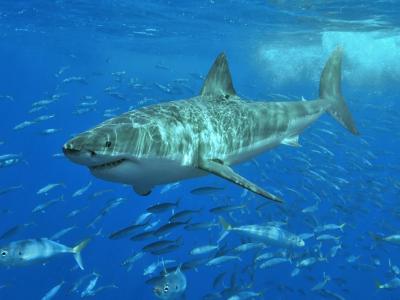
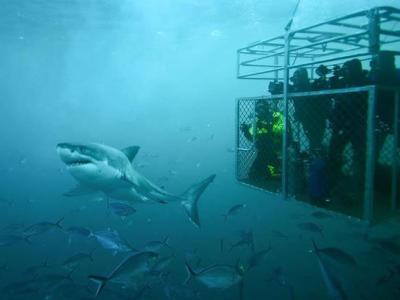
In Australia cage diving with great whites is only allowed around the Neptune Islands and to get here, you have to fly two hours from Sydney to Adelaide, then fly 45 minutes over to Port Lincoln and the Eyre Peninsula. The waters are teaming with life here and the tuna in the pens near Port Lincoln are harvested and shipped to the Tsukiji Fish Market in Tokyo. On a two to three hour cruise out you may see whales, dolphins, bronze whaler sharks, mako sharks, and there is a New Zealand fur seal colony that produces up to 4,000 new pups born November to December each year. There is even a small colony of Australian sea lions out here too.
May thru October are the best viewing times of the year as seal pups first venture off shore from where they born. Large female great whites are seen May, June and July, with the greatest number of great whites recorded in July and August. It’s recommended that you come to Port Lincoln the night before you dive, and spend the night after you dive as most boats are back by 6 pm, but every once in awhile weather or shark activity can push the return to port past 9 pm and that would mean missing your flight out that night. Some outfits are bait and berely (chum) free so you have the opportunity to see the great whites in their most natural state of seal predation. Most outfits have metal cages of various sizes attached to boat, but there is one new cage here called the “aqua sub” which is really a metal framed box with viewing windows in which you and others can enter or leave at any time while staying completely dry. You may also watch live television feeds from under the boat while sitting in the Galley. For those that really like to get wet, some trips come with optional excursions on boat tenders to go swim with the sea lions. Besides an average 12 hour long tour out to the islands and back, there are also other trips out here that may include up to 21 days on a liveaboard. Anchorage sites around the four islands that make up the Neptune Islands are selected depending on the time of year, the existing weather conditions, and local currents. Supplies to bring are similar to those needed during the aforementioned South Africa trips and supplies provided are similar to those supplied by South African great white charters.
If you really want to determine whether you like cage diving with great whites in South Africa better than cage diving in Southern Australia, or the other way around, then you will just have to dive both continents, and when it comes to seeing, filming, and viewing great whites face to face, getting to compare two absolutely astounding destinations like these could be a once in a life time adrenaline filled opportunity and an unforgettable experience with one of nature’s most feared, respected, and jaw drop impressive apex predators.
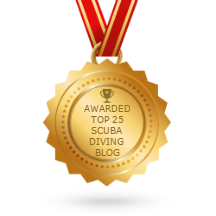
Recent Posts
- Eastern Malaysia, Sabah, Sipadan & More
- Ghost Pipefish, Pipefish, Seahorses, and Sea Dragons
- Australia Queensland and the Great Barrier Reef
- Tioman Islands, Malaysia
- The Riviera Maya
- The Peter Diving System
- The Bay Islands, Roatan, Utila, Guanaja, and more.
- The Cuttlefish; The Undisputed Master of Camouflage.
- The Maldives: A Garland of Islands in the Indian Ocean
- Frogfish, The Overlooked Camouflage Artist
Categories
- Australia
- Bahamas
- Bay Islands
- Belize
- Blue Hole
- Bonaire Diving
- Borneo
- Cayman Brac
- Cayman Islands
- Cozumel
- Curacao
- Cuttlefish
- Dive Destinations
- Dive Equipment
- Dive Liveaboards
- Dive Resorts / Properties
- Dive Travel
- Dive Travel Deals
- Diver Wellness
- Dolphins
- Dominica
- Eagle Rays
- eagle rays
- Family Travel
- Fiji
- Galapagos Islands
- Great White Shark cage diving
- Guanaja
- Honduras
- Indonesia
- Infographics
- Isla Mujeres
- Learning to Dive
- Little Cayman
- Maduro Dive Newsletter
- Malaysia
- Maldives
- Manta Rays
- Marine Life
- Mexico
- Micronesia
- Muck Diving
- Myamar
- Palau
- Papua New Guinea
- Pelagics
- Philippines
- Pinnacles
- Polynesia
- Reefs
- Riviera Maya
- Roatan
- Saba
- Sabah
- Scuba Diving
- Scuba Gear Reviews
- Scuba News/Events
- Scuba Training & Education
- Sea Legends
- sea lions
- Sea of Cortez
- Sharks
- Single Travel
- Sipadan
- Socorro Islands
- South Africa
- Specialties
- ST. Kitts
- Stingrays
- Tahiti
- Thailand
- The Bucket List
- Tobago
- Truk Lagoon (Chuuk)
- Turks and Caicos Islands
- Turtles
- Uncategorized
- Underwater Photography
- Underwater Video
- Utila
- Walls
- Whale Sharks
- Whales
- Wreck Diving
- Wrecks
- Yap
Archives
- January 2024
- April 2023
- March 2020
- March 2019
- January 2019
- November 2018
- September 2018
- July 2018
- May 2018
- March 2018
- January 2018
- October 2017
- September 2017
- June 2017
- April 2017
- February 2017
- January 2017
- October 2016
- August 2016
- July 2016
- May 2016
- March 2016
- February 2016
- January 2016
- December 2015
- August 2015
- June 2015
- April 2015
- January 2015
- November 2014
- July 2014
- April 2014
- February 2014
- December 2013
- November 2013
- October 2013
- September 2013
- August 2013
- July 2013
- June 2013
- May 2013
- April 2013
- March 2013
- February 2013
- January 2013
- December 2012
- November 2012
- October 2012
- September 2012
- August 2012
- July 2012
- June 2012
- May 2012
- April 2012
